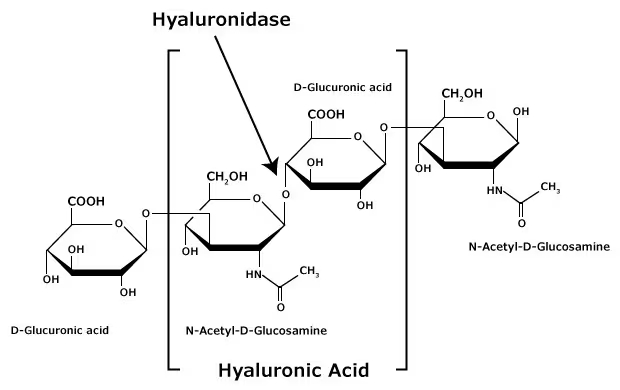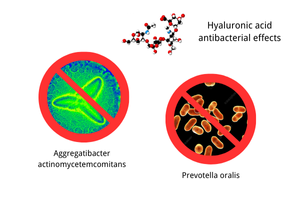The Role of Hyaluronic Acid in the Treatment of Periodontal Disease
Hyaluronic acid (HA) is a naturally occurring glycosaminoglycan. It was first discovered as early as 1880, and it has been used for decades in orthopedics, ophthalmology, and dermatology. However, it is only in recent years that its unique value in periodontal tissue repair and regeneration has begun to be recognized.
Molecular Properties of Hyaluronic Acid
HA is a macromolecular polysaccharide. It is composed of D-glucuronic acid and N-acetyl-D-glucosamine repeating disaccharide units. Its molecular weight differs widely between a few thousand to a few million Daltons. This is the reason for its diverse functions.
Fig 1. Hyaluronic Acid Structure
In the periodontal environment, HA exhibits the following key properties:
- Excellent biocompatibility: It can be utilized safely in inflammatory tissue milieus.
- High viscoelasticity: It can be employed as a biological barrier and space-maintaining material.
- Hydrophilic and moisturizing: It keeps a wet state for wound healing.
Mechanism of Action of Hyaluronic Acid in Periodontal Treatment
The advantages of hyaluronic acid applied in periodontal therapy are predominantly because of its regenerative and anti-inflammatory properties. These properties are particularly helpful in patients with severe periodontal pathology. Inflammation is one of the principal reasons for the advancement of periodontal disease. Chronic inflammation continuously damages periodontal tissues. HA helps to reduce inflammatory responses and inhibit the destruction of periodontal tissues. At the same time, it may contribute to tissue repair, promote gingival healing, and facilitate periodontal regeneration.
Evidence-Based Basis for Clinical Application
As a biomaterial with certain antibacterial activity, hyaluronic acid exerts inhibitory activity against many periodontopathogens. Because of this, it is beneficial as an adjuvant therapy for gingivitis and periodontitis. Pirnazar et al.[1] demonstrated that 1300 kDa molecular weight hyaluronic acid in a concentration of 1 mg/ml significantly inhibits Propionibacterium acnes, Staphylococcus aureus, Prevotella oralis, and Aggregatibacter actinomycetemcomitans. Rodrigues et al.[2] also compared the antibacterial activity of an HA-containing mouthwash with chlorhexidine mouthwash. They observed that hyaluronic acid also suppresses Aggregatibacter actinomycetemcomitans and Prevotella intermedia but not Porphyromonas gingivalis.
Fig 2. HA antibacterial effects
In addition to antibacterial action, hyaluronic acid also promotes healing of periodontal tissue through multiple mechanisms, such as anti-inflammatory, anti-edema, pro-angiogenic, and osteoinduction processes. It is noteworthy that its biological functions are closely related to molecular weight. High molecular weight HA can inhibit the release of inflammatory factors, suppress immune responses, and promote wound healing. On the other hand, low and medium-molecular-weight HA can cause the expression of inflammatory factors at certain times. It helps in balancing inflammation and healing.
In non-surgical therapy, topical application of hyaluronic acid can contribute to subgingival debridement. It significantly enhances probing depth, clinical attachment level, and bleeding on probing. In surgical therapy, hyaluronic acid is applied as a regenerative adjunct. It enhances the repair of soft and hard tissues.
It is particularly noteworthy that hyaluronic acid has promising potential in correcting “black triangles” in the anterior region. A papilla deficiency of more than 2 mm can form a visual black triangle, which affects aesthetics. By giving intermittent, micro-volume injections (each <0.2 ml) 2–3 mm apical to the papilla tip, hyaluronic acid can restore the shape and vertical dimension of the gingival papilla. This effectively removes the black triangle and enhances smile aesthetics.
Frequently Asked Questions (FAQ) on the Application of Hyaluronic Acid in Periodontal Disease Treatment
Q: What is hyaluronic acid (HA)?
A: Hyaluronic acid is a naturally occurring glycosaminoglycan present everywhere in human tissues. It performs several biological functions such as moisturizing, repairing, and regulating inflammation.
Q: How does hyaluronic acid benefit the treatment of periodontal disease?
It assists in the healing of periodontal health by inhibiting periodontal pathogens, reducing inflammatory reactions, and promoting tissue regeneration and repair.
Q: Do hyaluronic acids of different molecular weights have different effects?
A: Yes. High molecular weight HA (>1000 kDa) is targeted against anti-inflammatory and barrier functions, and medium and low molecular weight HA can, in some circumstances, modulate inflammation and repair.
Q: Against which periodontal pathogens is hyaluronic acid effective?
A: Studies have demonstrated that it is capable of inhibiting bacteria such as Aggregatibacter actinomycetemcomitans and Prevotella intermedia, but is not very effective against Porphyromonas gingivalis.
Q: Can HA be used as a substitute for conventional periodontal therapies?
A: No. It is generally used as an adjunctive method, along with conventional treatments such as subgingival debridement and surgery for optimum effectiveness.
Q: How is hyaluronic acid applied in non-surgical treatment?
A: It is often given in gel form or by local injection into periodontal pockets to help decrease probing depth, bleeding, and promote attachment regeneration.
Q: Is it used for periodontal surgical treatment?
A: Yes. It is particularly useful in regenerative and mucogingival surgeries, augmenting the outcomes of soft and hard tissue repair.
Q: Can “black triangle” issues be treated with hyaluronic acid?
A: Yes. Through micro-injections in the gingival papilla, it can restore height and shape, and improve aesthetics in the anterior tooth area.
Q: Does the usage of hyaluronic acid have side effects or risks?
A: Due to its high biocompatibility, side effects are very rare. It may cause temporary local discomfort in a few patients, but it is generally safe.
Q: Are there hyaluronic acid products that patients can use?
A: Some HA-containing mouthwashes or gels are available for daily use by the patients, but for therapeutic purposes, they should be under dental supervision.
About The Hyaluronic Acid Powder Supplier: Stanford Chemical Company
Stanford Chemical Company (SCC) is a trusted supplier of sodium hyaluronate powder, offering a comprehensive range of high, medium, and low molecular weight pure hyaluronic acid powders. SCC’s HA products are safe and reliable, backed by the following certifications:
- ISO 9001 (Quality Management System)
- ISO 14001 (Environmental Management System)
- ISO 22000 (Food Safety Management System)
[1] Pirnazar P, Wolinsky L, Nachnani S, et al. Bacteriostatic effects of hyaluronic acid [J]. J Periodontol, 1999, 70 (4):370- 374
[2] Rodrigues S V, Acharya A B, Bhadbhade S, et al. Hyaluronan-containing mouthwash as an adjunctive plaque- control agent[J]. Oral Health Prev Dent, 2010, 8(4): 389- 394


